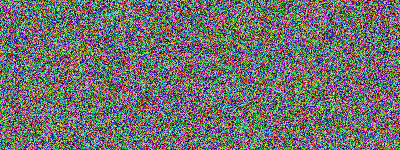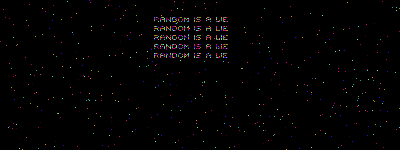I think there’s nothing interesting in this image. Do you agree? image

The image looks like it’s just a random noise. To make sure, we can measure a randomness. Pixels of each color can appear in each place of the image with equal chance. If it’s false for some colors, we certainly want to look at them. Here is a script for that:
<?php $fname = "quest.png"; $im = imagecreatefrompng($fname); list($sx, $sy) = getimagesize($fname); # ----------------------------------------------------------- # Divide the image into blocks and count a colors in each one # For each color calculate average count in one block # ----------------------------------------------------------- $xblocks = 8; $yblocks = 8; $xsize = intval($sx/$xblocks); $ysize = intval($sy/$yblocks); $count = $avg_count = array(); for ($yb = 0; $yb < $yblocks; $yb++) { for ($xb = 0; $xb < $xblocks; $xb++) { for ($y = $yb*$ysize; $y < ($yb+1)*$ysize; $y++) { for ($x = $xb*$xsize; $x < ($xb+1)*$xsize; $x++) { $c = imagecolorat($im, $x, $y); @$count[$yb][$xb][$c]++; }} foreach ($count[$yb][$xb] as $color => $color_count) { @$avg_count[$color] += $color_count/($xblocks*$yblocks); } }} # ----------------------------------------------------------- # Calculate a dispersion (deviation) from average count # for each color as sum of each block's squared difference # ----------------------------------------------------------- $d = array(); $dmax = 0; for ($yb = 0; $yb < $yblocks; $yb++) { for ($xb = 0; $xb < $xblocks; $xb++) { foreach ($count[$yb][$xb] as $color => $color_count) { @$d[$color] += pow($color_count - $avg_count[$color], 2); if ($d[$color] > $dmax) $dmax = $d[$color]; } }} # ----------------------------------------------------------- # Calculate average dispersion, just for information # ----------------------------------------------------------- $avg_d = 0; foreach ($d as $disp) { $avg_d += $disp; } $avg_d /= count($d); echo "MAX disp: ".round($dmax,2)."; AVG: ".round($avg_d,2)."\n"; # ----------------------------------------------------------- # Find the largest "gap" in array, use it as edge # ----------------------------------------------------------- asort($d); $gap = 0; $gap_disp = 0; $prev_disp = -1; foreach ($d as $color=>$disp) { if ($prev_disp > 0) { if ($disp - $prev_disp > $gap) { $gap = $disp - $prev_disp; $gap_disp = $prev_disp + ($disp - $prev_disp)/2; } } $prev_disp = $disp; } echo "GAP: ".round($gap_disp,2)." ± ".round($gap/2,2)."\n"; # ----------------------------------------------------------- # Blacken pixels with disp < $limit # ----------------------------------------------------------- $limit = $gap_disp; //we can use intval($dmax/3); for ($y = 0; $y < $sy; $y++) { for ($x = 0; $x < $sx; $x++) { $c = imagecolorat($im, $x, $y); if ($d[$c] < $limit) { imagesetpixel($im, $x, $y, 0); } }} imagepng($im, "solve.png"); echo "DONE.\n"; ?>
Well, if we run it, we get some information and an image with “bad pixels” in “solve.png”:
$ php solve.php MAX disp: 1492.41; AVG: 92.82 GAP: 351.61 ± 200 DONE.
The resulting image:

